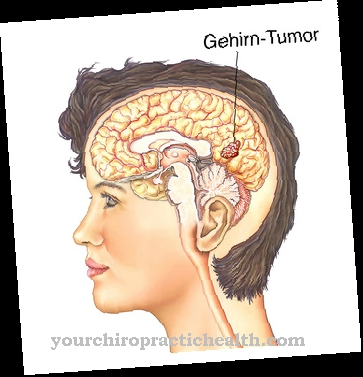Under a Malformation syndrome various congenital malformations are understood. Several organ systems are affected, which stand out due to multiple functional disorders. The diagnosis can often be made in the womb.
What is malformation syndrome?

© Olesia Bilkei - stock.adobe.com
The malformation syndrome is a very rare disease. Nevertheless, it has a diversified appearance. The syndrome is a combination of several malformations. Several organs of the patient are affected at the same time. In Europe, 3 percent of all newborns suffer from an embryonic malformation syndrome.
According to estimates, 50 to 70 percent of the diseased embryos die intrauterine. The malformation syndrome can be triggered by mutation of the genes or by viruses. There are around 500 different malformation syndromes that affect the kidneys or urinary tract. Others lead to complaints in other organs such as the heart or liver. The most well-known malformation syndromes include, for example, the following syndromes:
- Edinburgh Syndrome
- Triploidy
Acrocephalosyndactyly Syndromes such as:
- Carpenter syndrome
- Apert syndrome
- Apert-Crouzon Syndrome
- Pfeiffer syndrome
- Saethre-Chotzen syndrome
- Fetal alcohol syndrome
- Silver-Russell syndrome
- Patau syndrome
- Cri du chat syndrome
- Klippel-Trenaunay-Weber Syndrome
- Rubella embryo fetopathy
- Dzierzynsky syndrome
- Arnold Chiari Syndrome
- Ullrich-Turner syndrome
- Fraser Syndrome
- Smith-Lemli-Opitz syndrome
- Edwards Syndrome
- Noonan's Syndrome
- Sotos syndrome
- DiGeorge syndrome
- Holt-Oram Syndrome
The malformation syndrome is anomalies of various organs and body regions. It is noticeable that the anomalies occur in parallel. In the diagnostic process, the syndrome is usually traced back to a specific cause.
causes
Malformation syndromes can arise endogenously through a genetic disposition. In addition, they can also have various exogenous causes. They include viruses, infections and toxins, among others. Most malformation syndromes diagnosed prenatally are based on chromosomal causes.
Ultimately, every organ disorder that occurs in the patient can be traced back to a cause. This allows the malformation syndrome to be clearly differentiated from other organ disorders. These do not have a uniform etiology. Many malformation syndromes caused by genetic defects are inherited as an autosomal dominant trait.
The dominant inheritance means that the genetic defect present in at least one parent is automatically passed on to the child. The outbreak of the disease cannot be prevented because the dominant allele prevails over a recessive allele during the development phase of the embryo in its characteristic expression.
Symptoms, ailments & signs
The malformation syndrome always affects several body regions and organs in the patient. Since there are innumerable syndromes that can also occur in combination, the symptoms, complaints and signs in the patient are very individual and very numerous. Depending on the syndrome present, very different symptoms appear.
Deformation of the face, development disorders, overgrown fingers or toes and deformities of the vessels are possible. Growth disorders, development disorders of the midbrain, eye malformations or inner ear deafness also occur. Changes in the teeth, an excessively long aorta, a pelvic inclination or a mental or physical development delay are also diagnosed in some malformation syndromes.
Most of the time, visual abnormalities in the face shortly after birth are already prominent in newborns. In the further course of development, various organ disorders clearly appear in the patient. There is no spontaneous healing or relief of the symptoms. The number of symptoms is of such a variety that pains and disorders of various kinds cannot be overlooked.
Diagnosis & course
The diagnosis is usually made prenatally. If this is not the case, a diagnosis is made in early childhood at the latest. The failure of the organs leads to various examinations, which then provide more detailed information using methods such as X-rays, hormone and blood values. A genetic test is carried out during the course of the diagnosis to narrow down the chromosomal causes.
As symptoms persist and worsen as the child grows, a doctor should be consulted. If left untreated, the malformation syndrome can lead to death due to multiple organ disorders.
Complications
The complications of a malformation syndrome cannot be universally predicted, as they depend heavily on the malformations and their spread. In most cases, however, there are severe limitations for the patient in everyday life and in his life. The quality of life decreases sharply.
The malformation syndrome usually affects different organs and can occur either individually or in different organs at the same time. This can lead to hearing and seeing impairments that complicate the patient's everyday life. In some cases, developmental disorders occur due to the malformation syndrome.
This disorder can be both psychological and physical, so that patients often suffer from short stature and other growth disorders. Mental retardation can also occur. Spurred healing occurs only in very rare cases. Patients with developmental disorders often suffer from bullying and depend on the help of other people in everyday life.
In many cases, treatment can only alleviate the symptoms and not combat the underlying disease itself. The parents of children with malformation syndrome are often severely affected psychologically and need support from a psychologist.
When should you go to the doctor?
If the person concerned suffers from a malformation syndrome, this must definitely be examined by a doctor and continue to be treated. This disease usually does not heal itself and, in many cases, the patient's life expectancy is limited.
In order to increase life expectancy, those affected depend on treatment by a doctor. In most cases, the malformation syndrome is diagnosed before the birth or immediately after the child is born. Parents should always consult a doctor with their children if the malformations lead to restrictions in everyday life or impair the child's development.
In many cases, regular check-ups are also necessary to prevent further complications and complaints. If the parents cannot cope with the burden of the malformation syndrome, an abortion can be carried out in some cases. Since the syndrome can often lead to psychological upset or depression, treatment with a psychologist should always take place in parallel. Relatives and parents in particular depend on this treatment.
Doctors & therapists in your area
Treatment & Therapy
The treatment and therapy of the malformation syndrome depends on which syndrome is diagnosed. It must be clarified which organs are affected. The severity of the disease is then classified so that an individual treatment and therapy plan can be drawn up.
The individual treatments range from surgical interventions to drug therapy. The aim is always to alleviate the symptoms. A malformation syndrome disease cannot be completely cured. In many cases, surgical interventions are carried out to ensure that the organs are supplied and properly functioning.
These can affect the heart, kidneys or, for example, the bladder. For some syndromes, a bone marrow transplant is performed. This should strengthen the immune system. By inserting new functioning immune cells in the organism, these are integrated and the patient can experience permanent relief.
Vessels may possibly be removed. It can also be decided that extremities should be aligned. The administration of drugs or hormones is not uncommon. The blood values are checked regularly in order to supply the body with missing substances or to check the blood sugar level. The sick children usually take part in various early intervention programs to support their development well.
Psychotherapy is often recommended to be able to deal with the symptoms. The relatives are also advised to seek psychological support so that they can better face the challenges of everyday life.
Outlook & forecast
The prognosis of the malformation syndrome depends on the individual disorders and the severity of the disease. Overall, despite all efforts, it is considered unfavorable. The mortality rate is particularly high in the first few weeks of development of the embryo. More than half of the affected fetuses still die in the womb due to the severity of the organic disorders present. Without permanent medical care, patients are often not able to survive even after birth.
In the case of less severe malformations, the scientific and medical possibilities can alleviate the symptoms in the further course of development. The treatment depends on the respective symptoms and is specifically developed based on the needs of the patient.
Early intervention programs, good care and therapies help the child to develop optimally. As far as possible, the resulting mutations are corrected in surgical interventions. Other abnormalities can be treated with organ transplants or artificial aids.
A cure for the diagnosed syndrome has so far been ruled out. However, symptomatic treatment can be very effective in many patients. The affected person will still have lifelong impairments and must undergo regular examinations. The vulnerability for the development of further diseases is increased. The lifetime is reduced in most types of malformation syndrome.
prevention
In Germany, diagnosis can be made during pregnancy. It is considered a possible indication for an abortion (§218a StGB). Expectant parents are informed about the theoretical life expectancy and learn more about the problems that can be expected of the surviving child.
Aftercare
As a rule, the options for follow-up care for malformation syndrome are extremely limited. Complete healing is also not possible because the malformations are usually hereditary. Therefore, only a purely symptomatic and not a causal treatment can be used. Furthermore, if the person concerned wishes to have children, genetic counseling can also be carried out in order to prevent the syndrome from being passed on to the descendants.
However, self-healing cannot occur. Whether the life expectancy of the person affected is reduced by the malformation syndrome cannot be universally predicted. In most cases, those affected are dependent on intensive care and permanent support from their parents and family.
Above all, loving and intensive care has a positive effect on the course and can prevent complications. Furthermore, regular examinations by doctors are necessary in order to detect and treat damage to the body and internal organs at an early stage. Talking to friends or family is also very helpful in alleviating these symptoms in the event of psychological upset or depression. Contact with other sufferers of the syndrome can also be useful.
You can do that yourself
The possibilities of self-help are very limited in the case of malformation syndrome. The syndromes are considered incurable with current medical possibilities. In everyday life, an emotional stabilization of the patient and the relatives is necessary in order to deal with the malformation syndrome.
Due to the illness and the large number of complaints, the psychological stress is very high. Joint activities and individual leisure activities are important to promote wellbeing. The quality of life of the patient can be improved with a healthy lifestyle, a balanced diet and sufficient exercise.
The available options are to be adapted to the respective malformation syndrome and should be aimed at promoting the self-esteem of the person affected. If optical flaws are to be covered, this can be done with clothing or accessories. It is helpful to deal openly with the disease and to tell people in the immediate vicinity about the symptoms and effects of the malformation syndrome.
Relatives as well as sick people can use relaxation techniques to build up their mental strength for the challenges of everyday life. Methods like yoga or meditation help to create an inner balance. Discussions and exchanges with other sick people also help. Tips and advice can be exchanged in self-help groups or forums. Existing fears or experiences are discussed and can help relieve pressure.


.jpg)



.jpg)

.jpg)



















